Product Vision vs. Product Strategy: Understanding the Key Differences and Their Impact on UX Design
No matter your industry, user experience (UX) is a critical factor in the success of your products. By clearly defining your product vision and product strategy, you can create seamless and engaging experiences for your users.
Some products are more appealing to users because of the effective use of product vision and strategy in their UX design.
But what are these concepts, and how do they affect user experience?
In simpler terms:
Product vision → What we want to achieve
Product strategy → How we plan to achieve it
Product vision and strategy are both extremely important. They help keep the team excited and focused while creating the best products. Without them, it's easy to get off track.
In this article, we'll talk about why great products need both vision and strategy and how they work together. We'll see why you can't have one without the other if you want your product to succeed with great user experience.
What is a Product Vision?

A product vision is a clear and concise statement that outlines what you hope your product will become when fully developed.
You can't reach this vision quickly. It's not something you can finish in just a few updates. Instead, it's a far-off goal that you keep moving towards with each improvement.
This ultimate goal isn't just to impress people with money or experts. Its main job is to help everyone in the company focus on the same goal. It guides the whole plan for the product.
Most importantly, the product vision helps everyone know why the product exists. When everyone understands this, from new programmers to top bosses to the sales team, they all work together to make the product better and closer to this vision.
Need help with your product vision? Consider joining a product vision workshop.
It answers these questions:
What change will the product bring?
What feelings and emotions will it create in users?
How is it different from other similar products?
Why Product Vision in UX Matters
A product vision statement is created to match what the company wants with what customers need. It also helps the design, development, and product teams work better together. This vision is really important when making products that focus on user experience.
The Product Vision vision statement:
Connects company goals with what customers need
Brings together design, development, and product teams
Helps guide how we create products focused on user experience
Real examples of effective product vision statements:
HubSpot’s Vision: “Hubspot gives you the software, services, and support you need to do marketing the right way, all in one place.”
Amazon’s Vision: “To be Earth’s most customer-centric company; to build a place where people can come to find and discover anything they might want to buy online.”
Uber’s Vision: “Transportation as reliable as running water, everywhere for everyone.”
Google’s Vision: “To provide access to the world’s information in one click.”
Peloton’s Vision: “Use technology and design to connect the world through fitness. Empowering people to be the best version of themselves anywhere, anytime.”
Salesforce’s Vision: “To empower companies to connect with their customers in a whole new way.”
These statements can help you understand product vision.
Here's what these vision statements have in common:
They're short and simple sentences.
They use general words, not specific details.
They don't give exact steps or time limits. This is because strategies and plans can change often, but a vision should last for many years.
They inspire everyone who works on the product.
A product vision helps everyone work together towards the same goal. This way, people make choices that are good for the long term, not just for right now.
What is a Product Strategy?
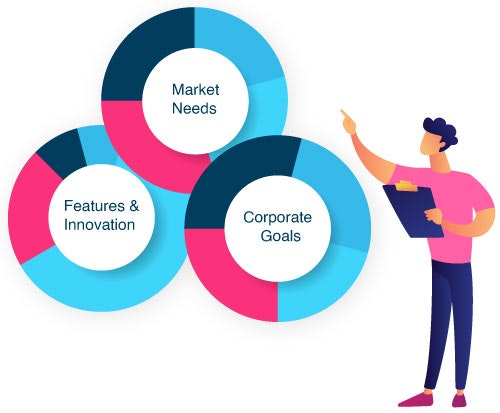
Once a company knows its product vision, it needs a plan to get there. That's where product strategy comes in.
Let's see how product strategy is different from product vision.
A great product strategy starts by really understanding what customers need. You need to think about:
Who is your target customer?
What special thing does your product do?
How do you want users to feel when they use your product?
These ideas help you create buyer personas, choose target markets, and decide how to make money. When you know your users, you can set smart goals. These goals focus on results you can measure, like how many people keep using your product or how much money you make over time.
If you need help with your design strategy, see our guide on the best design strategy firms
Key Components of a Product Strategy
A product strategy should give a big-picture view without too many details
A product strategy should be flexible and able to change
A product strategy should cover about 1-3 years (longer than that might get outdated)
What Makes a Good Product Strategy?
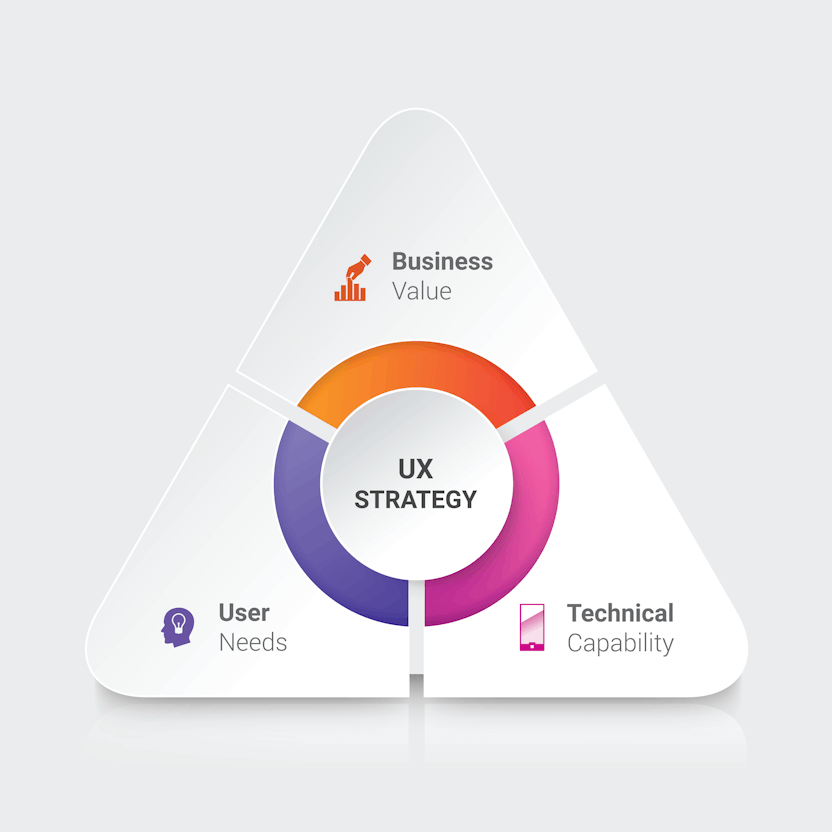
A good product strategy is:
Focused on customers:
It's based on knowing what your users need
Clear and doable:
It has a plan with specific steps
Prioritized:
It decides what's most important to work on first
Adaptable:
It can change if the market or customer needs to change
Team-based:
Everyone important helps make it
Based on data:
It uses research and customer feedback
Ongoing:
It keeps checking and improving over time
Remember, stick to your big goal, but you can change how you get there.
To get everyone on the same page with your vision, consider attending a product strategy workshop.
What is the Difference Between Product Vision and Product Strategy
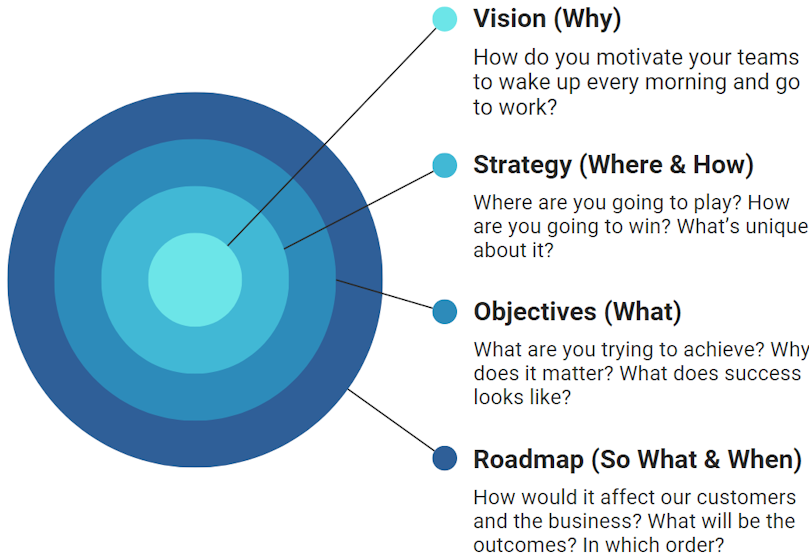
The main difference between product vision and product strategy is that product vision shows where you want your product to end up. On the other hand, the product strategy explains how to get there
Here's an example to make it clearer:
The product vision for an E-commerce Platform is:
"To create an easy-to-use online marketplace where people can buy and sell all kinds of things."
Their product strategy is to:
1. Make the website easy and safe to use
2. Add good search tools and product suggestions
3. Use data to understand what customers want
4. Make sure products are delivered well and help customers when they need it
1. Level of Detail
Vision and strategy differ in how specific they are:
Vision: Is general and open to different interpretations
Strategy: Gives more specific directions on how to reach goals
2. Emotional Effect
Product vision and strategy affect emotions differently:
Vision: Aims to inspire everyone involved with the product
Strategy: Focuses more on logical thinking and analysis
3. Timeframe
Vision and strategy cover different periods:
Vision: Looks far into the future, often decades ahead
Strategy: Usually plans for 1-3 years
4. Flexibility
This refers to how vision and strategy handle change:
Vision: Stays the same for a long time
Strategy: Can change to fit new situations
For example, Peloton’s vision of "Use technology and design to connect the world through fitness". didn't change during the pandemic. But their strategy changed quickly to serve more than just tech-savvy individuals when everyone suddenly needed online fitness classes. .
Step-by-Step Guide to Developing a Product Vision Statement
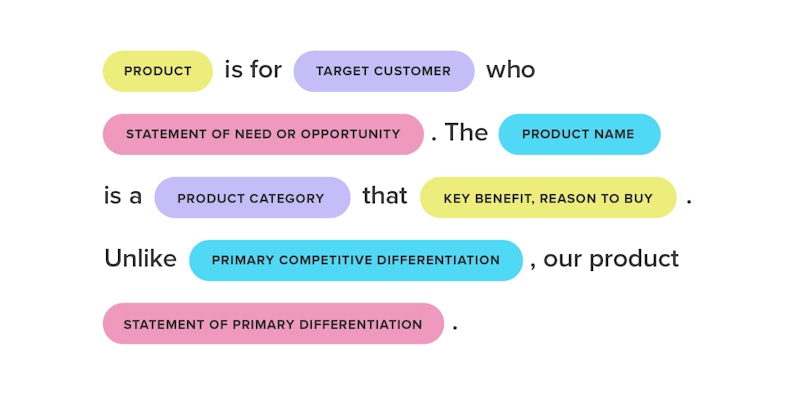
Step 1: Collect Information
Look at what your competitors are doing
Talk to important people in your company
Learn about your product's value
Understand who your users are
Talk to potential customers
Conduct product testing if possible
Step 2: Organize Your Information
Put all your research together
Make a list of what your product does and what customers need
Get ready to share this with your team
Step 3: Review with Your Team
Show your research to everyone
Ask team members what they think
Use colored dots to mark ideas they like, dislike, find surprising, or think are very important
Step 4: Come Up with Ideas
Think about how you want things to be in the future
Ask questions like "Where do we want to be in the next 5-6 years?"
Have everyone write down ideas
Group similar ideas together
Vote on which ideas are most important
Step 5: Write Your Vision Statement
Use the most important ideas to write your vision statement
Let one person make the final version
Step 6: Share Your Vision
Tell other teams about your vision
Make something to help people understand your vision (like a document or video)
This helps everyone work towards the same goal
Learn how to make a strong vision statement with our product vision statement article.
How to Start Creating a Strong Product Strategy?

Strategy is important because it guides your team's work for the next couple of years. To begin, focus on your customers.
Define your TAM or Total Addressable Market and plan how to reach it. You might start with one segment, like a specific user group or location, then expand to others until you cover the whole TAM.
For example, you could launch your product in your home country first, then move to other countries. Or you might target different types of users one by one. For business products, you could focus on different industries over time.
When creating your strategy, involve key people like the head of product, technology, and product marketing. If your startup is small, you might include the whole team.
How to Use Vision and Strategy Together?
Your product vision can help guide your strategy. It's easy to find strategy templates online, but always ask if each step brings you nearer to the ultimate goals described in your vision. This helps you avoid unnecessary work and reach your goals faster.
1. Start with your vision to set your long-term goal
2. Use your strategy to plan how to reach that goal step by step
3. Always check if your strategy choices align with your vision
4. Involve your team in both product vision and product strategy discussions
By keeping your vision in mind while developing your strategy, you can create a product that truly achieves what you set out to do.
Product Vision and Strategy: Best Practices
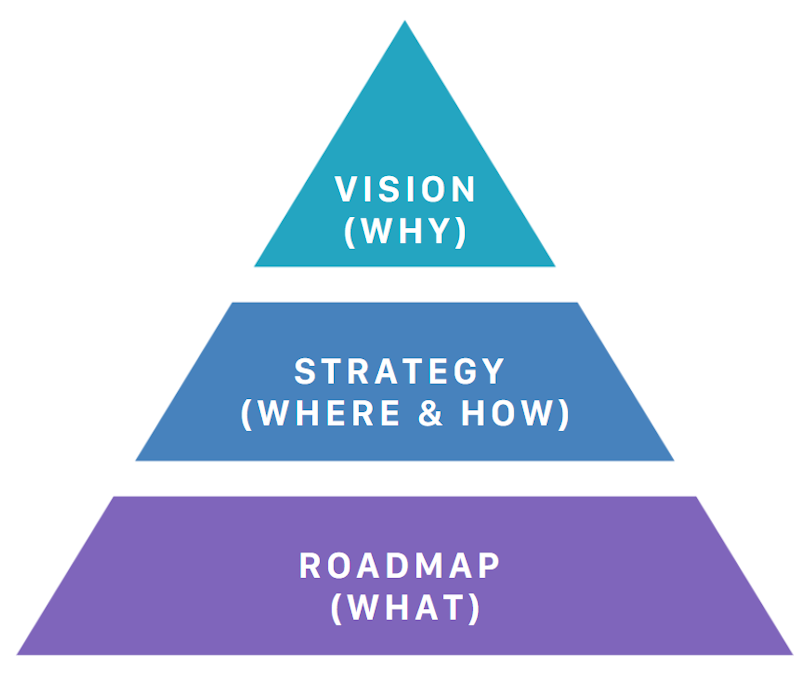
Let's look at some important principles for both product vision and strategy:
1. Focus on Consumers, Not Competitors
Your vision and strategy should keep you on your path. Following competitors might make you second best. Following your ideas can give you the first mover advantage.
Stay ahead by reading our guide on competitive analysis.
2. Focus on Your Product’s USP
Make sure you can explain what's special about your product and why customers will want it.
3. Match Company Goals
Your product strategy should fit with what your company wants to achieve. This helps create value for customers and the company without causing problems between departments.
4. Work with Cross-functional Teams
Talk to other teams like marketing, customer support, and sales. This helps make your product strategy work better.
5. Make Data-driven Decisions
Look at research and what customers say to guide your strategy. This helps you make better choices.
6. Be Ready to Change
Be flexible to change your strategy if needed. Markets and customer needs can change quickly.
Make your strategy sessions better with our strategy workshop exercises.
Wrapping Up
Product vision and strategy are extremely important for new products. A clear vision helps inspire your team and gives everyone a shared goal. A solid strategy gives you a plan to reach your goal, ensuring you focus your resources on the most important tasks.
Once you have your vision and strategy ready, you can start working on your product roadmap. This is your next step in planning how to make your product successful.
Remember, a strong vision and strategy work together to help you create a product that customers want and that stands out in the market.
Can you have a strategy without a vision?
While you can have tactics without a strategy, it's challenging to have an effective strategy without a vision. Your strategy should be informed by your vision and guide your tactics. Strategy requires long-term planning and focus, which is difficult without a clear vision to aim for.
What is product vision vs strategy vs roadmap?
Product vision defines the "What" and "Why" of your product. Product strategy details how to bring that vision to life with a specific approach. The product roadmap provides a timeline for executing that strategy.
What are the three elements for a UX strategy?
A solid UX strategy typically consists of three main elements: Vision, Goals and Measures, and Plan. These are built on a foundation of UX research, design principles, and continuous evaluation and iteration.
What is the difference between product strategy and UX strategy?
Product strategy takes a broader view, covering everything from market analysis and business goals to product development and launch. UX strategy, however, zeroes in on user pain points, needs, motivations, and how users interact with the product interface.
Why is vision more important than strategy?
Experience shows that focusing on strategy (the "how") too early can limit your vision (the "what"). It might keep you from thinking as big as you need to. What you really need is a vision so compelling that it inspires not just others, but you as well.
Which should come first: product vision or strategy?
Your product vision is your end goal - what you want to achieve. Your mission outlines the general approach to reaching that vision. Strategies are specific plans that use your mission to work towards your vision. Goals are concrete milestones that help implement your strategy.





